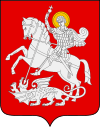2011 Georgian protests
The 2011 Georgian protests were a series of anti-government protests in Georgia against President Mikheil Saakashvili.
| 2011 Georgian protests | |||
|---|---|---|---|
| Date | 21–26 May 2011 | ||
| Location | |||
| Goals | Resignation of President Mikheil Saakashvili, political reforms | ||
| Methods | Demonstrations, civil disobedience | ||
| Status | Inconclusive | ||
| Casualties and losses | |||
Events
The protests began on 21 May 2011 when over 10,000 Georgians attended a demonstration in Tbilisi demanding Georgian President Mikheil Saakashvili's resignation. In the southwestern city of Batumi some demonstrations also occurred with some protesters attempting to break into television building.[3] Nino Burjanadze, an ex-parliamentary speaker and leader of the Democratic Movement-United Georgia party, has been a lead figure in the demonstrations.[4] The protesters in Batumi briefly clashed with police.[5]
Burjanadze stated that one of the aims of the protesters was to prevent a parade commemorating Independence Day on 26 May 1918 from taking place in Freedom Square in Tbilisi.[6] On 26 May at about 00:15, Georgian police began to suppress the protests with tear gas and rubber bullets, and the protests soon ended. Burjanadze apparently fled in a motorcade which ran over one protester and one policeman (killing them both; two more bodies later showed up as well, apparently electrocuted by a loose wire).[1]
On the 28 May, a separate demonstration was held with thousands of participants, protesting against violence both by the protesters and by the police.[1]
Arrests
In early June, Georgian authorities arrested and charged Badri Bitsadze, husband of former parliament speaker Nino Burdzhanadze, with attempting to orchestrate the government takeover using paramilitary groups during the violent anti-government protests.[7] There have been 105 other arrests of protesters.[2]
Reactions
Mikheil Saakashvilli stated that he believed the protestors were backed by Russia and had provoked the violence.[2] Likewise John R. Bass, the American ambassador to Georgia, stated that "here were clearly a number of people included in that protest who were not interested in peacefully protesting, but were looking to spark a violent confrontation."[2] The Georgian Interior Ministry released video recordings that it claims show opposition members discussing how to instigate clashes with police[2][8] The Economist, meanwhile, spoke of an attempt by Burjanadze to "claw her way back to power".[1]
Irakli Alasania (an opposition leader who disassociated himself from the protests early on) opined that the protests were doomed to failure because:
The era when politicians can just call people on the streets is over. Georgia is building a new political culture. People want to determine Georgia’s future through elections.[1]
See also
References
- "Protests in Georgia:On Rustaveli Avenue". The Economist. 2 June 2011. Retrieved 15 July 2011.
- Ellen Barry (28 May 2011). "Bodies Found Near Site of Protests in Georgia". New York Times. Retrieved 15 July 2011.
- Reuters; Georgian protests, TV building attacked
- Civil.Ge; Protesters March to Public Broadcaster Archived 7 June 2011 at the Wayback Machine
- Civil.Ge; Police Briefly Clash with Protesters in Batumi Archived 6 August 2011 at the Wayback Machine
- "Opposition rally aims to prevent Georgia independence parade". RT. 25 May 2011. Retrieved 17 July 2011.
- "Archived copy". Archived from the original on 11 July 2011. Retrieved 2 June 2011.CS1 maint: archived copy as title (link)
- Georgian Interior Ministry, Georgian Interior Ministry
